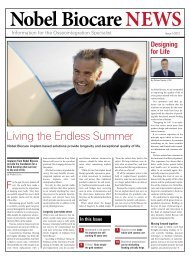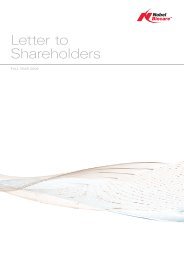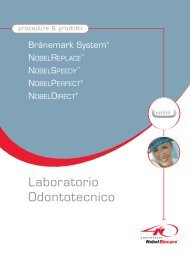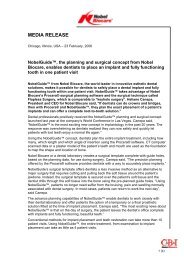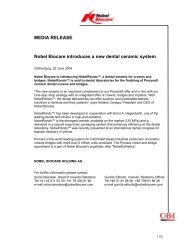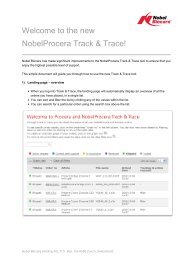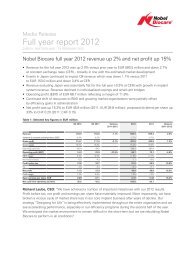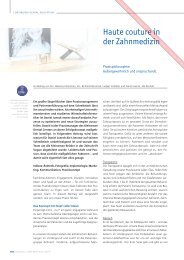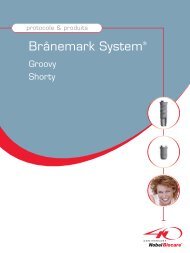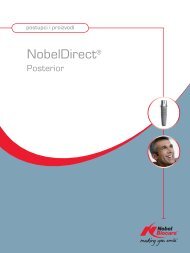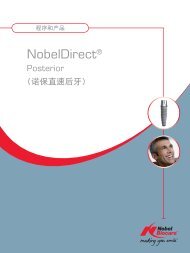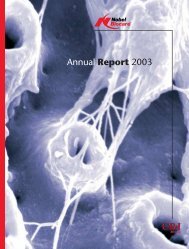clinical - Nobel Biocare
clinical - Nobel Biocare
clinical - Nobel Biocare
Create successful ePaper yourself
Turn your PDF publications into a flip-book with our unique Google optimized e-Paper software.
All-on-Four Immediate Function Treatment<br />
tissues were readapted to obtain a primary<br />
closure around the abutments and fresh<br />
extraction sites and then sutured back into<br />
position with interrupted resorbable 4.0<br />
chromic sutures (Salvin Dental Specialties,<br />
Charlotte, NC). Local bone grafting to cover<br />
exposed threads and/or other osseous defects<br />
associated with extraction sockets was<br />
performed at 64% of implant sites with<br />
demineralized bone matrix gel (Dyna graft-<br />
D, Keystone Dental, Boston, Mass), and 1% of<br />
implant sites were grafted with autogenous<br />
bone from the local surgical area.<br />
Straight, 17u multiunit abutment, internal<br />
(<strong>Nobel</strong> <strong>Biocare</strong>), and 30u angulated multiunit<br />
abutments, internal (<strong>Nobel</strong> <strong>Biocare</strong>), were<br />
used to achieve relative parallelism of the<br />
implants so that a rigid prosthesis would<br />
seat in a passive manner.<br />
Open-tray multiunit impression copings<br />
(<strong>Nobel</strong> <strong>Biocare</strong>) were placed on the abutments,<br />
and an impression was made with a<br />
custom open tray using precision impression<br />
material (Flexitime, Heraeus Kulzer, Hanau,<br />
Germany). Patients were instructed to avoid<br />
brushing and to use warm water rinses for<br />
the first postoperative week. A cold or roomtemperature<br />
soft diet for the first 24 hours<br />
following surgery was recommended, followed<br />
by a semisolid diet for the next<br />
3 months. Patients were given antibiotics<br />
and analgesics as listed in the surgical<br />
protocol. A CBCT scan was taken immediately<br />
postoperatively to verify the implant<br />
positions and the prosthetic components.<br />
Prosthetic protocol<br />
A provisional denture was prefabricated with<br />
heat-cured acrylic resin (Ivocap high-impact<br />
acrylic, Ivoclar Vivadent, Schaan, Liechtenstein)<br />
prior to the surgical procedure. Immediately<br />
following surgery, the denture was<br />
modified to the master model in the<br />
laboratory. Fabrication was completed using<br />
cold-curing material (Probase, Ivoclar Vivadent).<br />
This provisional all-acrylic resin pros-<br />
434 Vol. XXXVII/No. Four/2011<br />
TABLE 1<br />
Torque values (implant insertion)<br />
Ncm n %<br />
,35 14 1.98<br />
35 40 5.65<br />
36–45 53 7.49<br />
46–55 41 5.79<br />
56–65 41 5.79<br />
66–70 471 66.53<br />
Not recorded* 48 6.78<br />
Total 708 100<br />
*Implants achieved primary stability, although<br />
torque was not noted in numerical values.<br />
thesis was seated within 3 to 4 hours of<br />
completion of surgery on the same day. The<br />
patients were scheduled for routine followup<br />
visits after surgery at 1 week, 2 weeks,<br />
4 weeks, and 3 months postoperative and on<br />
a yearly basis. At the 3-month appointment,<br />
fabrication of the definitive prosthesis was<br />
initiated.<br />
Periapical digital radiographs using a<br />
parallel technique were obtained at the 3month<br />
appointment and thereafter on a<br />
yearly basis from the date of the surgery<br />
(Figures 7, 13, 14, 20, and 29). Implants were<br />
checked by visual observation for plaque<br />
and bleeding on probing at the follow-up<br />
intervals. Periapical radiographs and plaque<br />
and bleeding indices at various follow-up<br />
intervals are part of routine care for patients<br />
at the clinic and not a part of the analysis in<br />
this study.<br />
The definitive prostheses consisted of a<br />
milled titanium frame with a wrap-around<br />
heat-cured acrylic resin (Ivocap high-impact<br />
acrylic). All restorations were performed by 1<br />
clinician (G.T.K.).<br />
Survival criteria<br />
The modified Albrektsson criteria used in this<br />
investigation are the following: an implant<br />
was regarded successful when there was (1)<br />
no radiolucency around the implant; (2) no<br />
signs of infection, pain, or ongoing pathological<br />
processes at the implant site; (3) the



